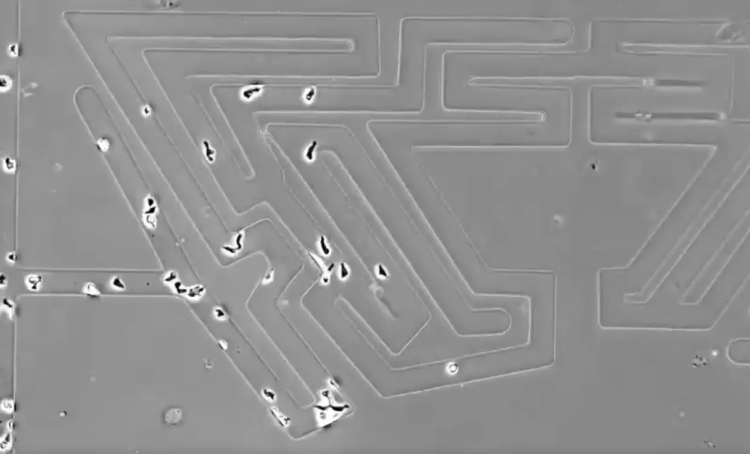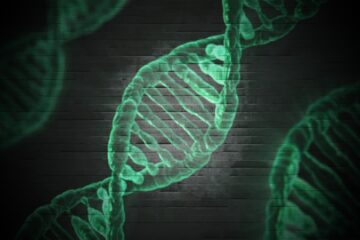Study: Single-Celled Organisms Can Solve Complex Mazes
Cells intuitively avoided dead-ends when released into microscopic mazes. Here’s how.
FOR A SINGLE CELL, the human body is a gargantuan maze of tissues, chemicals and capillaries, crammed full with trillions of other cells all bustling about like commuters at the world’s busiest train station. Somehow, amidst all this hubbub, most cells still manage to reach their destinations.
How do they do it? Many cells have a trick up their sleeves known as chemotaxis — essentially, the ability to navigate by sensing the presence or absence of chemical attractants in the environment. Sperm cells use chemotaxis to find eggs, white blood cells use it to rally around infection sites and cancer cells use it to metastasize through vulnerable tissues.
So, can an amoeba use chemotaxis to solve the world’s most infamous hedge maze? That’s precisely what happened in a new study published today (Aug. 27) in the journal Science.
To test the power of a specific form of chemotaxis employed by the farthest-traveling cells, researchers created miniature versions of the hedge maze at Hampton Court Palace (once the residence of King Henry VIII and his descendants) plus dozens more microscopic labyrinths of varying complexity. Remarkably, when amoebas were released in these mazes they darted to the exits with incredible accuracy, using chemotaxis to effectively “see around corners” and avoid dead-ends before they even reached them, study author Robert Insall said.
“The cells aren’t waiting for someone to tell them what to do,” Insall, a professor of mathematical and computational cell biology at the University of Glasgow in Scotland, told Live Science. “By breaking down the chemicals in front of them, they know which branch of the maze leads to a dead-end and which leads [to the exit]. It’s absolutely unbelievable.”
Cells in a Maze
In their new study, the researchers focused on a specific form of cell navigation called “self-generated” chemotaxis. It relies on a simple philosophy: cells want to move from areas of a lower concentration of attractant (in this case, an acidic solution called adenosine monophosphate) into areas with a higher concentration.
“It’s sort of like the old saying, ‘the grass is always greener on the other side of the fence,'” Insall said. “The cows have eaten all of the grass where they are, and they want to get into the surrounding field where the grass is still growing.”
But sometimes there are multiple “fields” to choose from, illustrated in this study by the multiple branching paths of a maze. To determine which branch holds the higher concentration of attractant, cells break down the molecules in front of them, causing attractant from the nearby areas to diffuse toward them. As the cells move forward, the attractant ahead of them depletes more and more; eventually, short, dead-end branches of the maze are totally depleted of attractant, even before the cells reach the exit to a dead end. When faced with a short, depleted branch and a long, attractant-filled branch, the cells will never take the dead-end route, Insall said.
“They really can see around corners,” Insall said.
The researchers illustrated this phenomenon with computer models at the start of their study, but wanted to see it in action, too. So, they created more than 100 microscopic mazes by etching grooves onto a silicon chip, with each path measuring between 10 and 40 microns wide. (For comparison, the thinnest human hairs measure about 20 microns wide).
Mazes ranged from easy (just a few branching paths before the exit) to difficult (with long dead-end paths, like the Hampton Court hedge maze replica) to impossible (according to Insall, a replica of Scotland’s Traquair House maze had to be scrapped, because all the amoebas kept dying before they solved the puzzle).
The researchers cast these tiny mazes in rubber, then flooded them with a fluid attractant that was piped in from the maze exit. At the start of each maze, soil amoebas called Dictyostelium discoideum lined up and began to swim forward, breaking down the fluid molecules before them. The longest mazes took about 2 hours for the savvy cells to solve, Insall said, while the shorter ones took just 30 minutes.
The real-life cells performed exactly as the team’s models predicted; when faced with the choice between a short dead-end path and a long path that led toward the exit, the cells always chose the long path. In harder mazes, which included dead-end paths that were just as long as the correct path, cells chose correctly about 50% of the time. In both cases, cells that entered the maze first were the most likely to reach the exit; cells that straggled found that every path, even the correct one, had already been depleted of attractant by their competitors, leaving the stragglers no information about where to go.
“The amount of information cells can read by breaking chemicals down is much more sophisticated than anyone thought,” Insall said. “That makes us think that most biological problems, where cells have to find their way from one place to another, almost certainly use a mechanism like this.”
Even though the study focused on amoebas, the researchers believe the results should hold true for any number of human body cells — be it blood cells darting through tissues to reach an infection, or cancerous glioblastoma cells swimming down white matter channels of the brain. The type of attractant is likely different in each situation (and, in many cases, is still unknown to scientists), but for cells navigating the winding labyrinth of our bodies, figuring out where the grass is greener may be the best way to go.
* * *
Source: Live Science







Underestimating the intelligence of other living creatures, some that we’ve exploited or exterminated as pests, may be among the biggest tragedies in world history. Our arrogance likely comes from the Abrahamic religions putting man above the natural world, as its master.
Namaste Dr Gupta. A cat entered my home yesterday and and said “hello”: to me. It wanted food.
One of the first laws that Hitler introduced was for the protection of animals.
Some time ago, I had a Christian fellow come over to do some yard work. I would classify this 33 year old individual as a rabid Christian, as he has little money, no vehicle or drivers license, yet spends inordinate amounts of income on monstrous, leather-bound, gold-leafed Bibles of which he has purchased several examples. These Bibles weigh upwards of 25 lbs and cost around $700 ea. As we walked through the yard, I pointed out several cobwebs with spiders in them. I had purposely been avoiding these webs so as not to disturb them. I said, “Watch out for the spider webs.” He immediately tore through the webs bellowing with a commanding voice, worthy of Charlton Heston in the role of Moses, “I HAVE DOMINION over these creatures!!”… Read more »
So single cell organisms are smarter than congoids :D
Well at least they don’t burn down and loot the maze.
So our bodies are composed of intelligences, which can operate on their own? And they are entities in their own right? And so are the bodies of other creatures?
I don’t even know where to go with this, or where it will lead.
What is the Cosmotheist take on this?
It is a new idea to me, so my thoughts on it are not fully formed. But is it really so surprising that the rudiments of decision-making, awareness, and consciousness exist in amoebe? A tree is in a sense conscious of gravity and therefore also of its own angle with respect to the average contour of Earth, and slowly orients itself so that its trunk, branches, and roots go in the proper directions.
All consciousness is a manifestation of Vril energy and conscious physical beings are simply sense organs for the universe. It doesn’t surprise me at all that microbes are intelligent in ways we cannot perceive.
Want to take a truly bizarre trip down the rabbit hole? Read the “Ringing Cedars” series by Vladimir Megre. http://www.vladimirmegre.com/vladimir_megre_story.php. I found this series really resonates with white women. “The Ringing Cedars may be described as a nature religion, since Anastasian spirituality emphasises the sacredness of nature or generation, conceived as a source of divinity and the means of communication with God (Rod). The scholar Rasa Pranskevičiūtė characterises this vision as pantheistic, and notes how it is a fundamental influence in Anastasians’ social project. They stress the importance of harmony, that is to say giving and receiving love and respect, appropriate reciprocal cultivation, to be put into practice among individual persons and between the community of individuals and the divinity of all nature.” I dunno’ it all… Read more »
“In their new study, the researchers focused on a specific form of cell navigation called “self-generated” chemotaxis. It relies on a simple philosophy: cells want to move from areas of a lower concentration of attractant (in this case, an acidic solution called adenosine monophosphate) into areas with a higher concentration.”
In my new study, I focused on a specific form of White navigation called “self-love” racialotaxis. It relies on a simple philosophy: Whites want to move from areas of a lower concentration of White “self-love” (in this case, an acidic solution called non-White Judism) into areas with a higher concentration of White “self-love”.